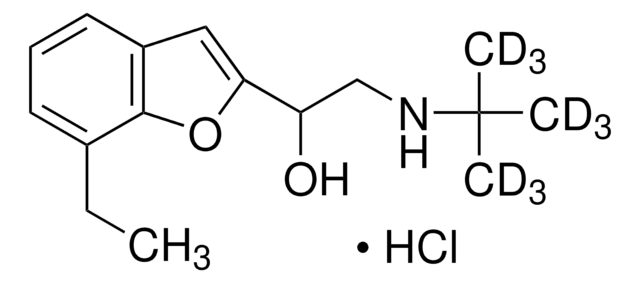B-052
(±)-Bupropion-D9 hydrochloride solution
100 μg/mL in methanol, ampule of 1 mL, certified reference material, Cerilliant®
About This Item
Polecane produkty
klasa czystości
certified reference material
Postać
liquid
Właściwości
(Snap-N-Spike®)
opakowanie
ampule of 1 mL
producent / nazwa handlowa
Cerilliant®
stężenie
100 μg/mL in methanol
metody
gas chromatography (GC): suitable
liquid chromatography (LC): suitable
Zastosowanie
clinical testing
format
single component solution
temp. przechowywania
−20°C
ciąg SMILES
CC(NC(C([2H])([2H])[2H])(C([2H])([2H])[2H])C([2H])([2H])[2H])C(C1=CC=CC(Cl)=C1)=O.Cl
InChI
1S/C13H18ClNO.ClH/c1-9(15-13(2,3)4)12(16)10-6-5-7-11(14)8-10;/h5-9,15H,1-4H3;1H/i2D3,3D3,4D3;
Klucz InChI
HEYVINCGKDONRU-WWMMTMLWSA-N
Opis ogólny
Zastosowanie
- Pharmaceutical and nanotechnology applications: Bupropion-D9 hydrochloride is used in the development of UV-triggered drug release systems involving mesoporous titanium nanoparticles loaded with pharmaceutical agents, demonstrating its utility in enhancing drug delivery mechanisms and controlled release technologies (Zuo et al., 2024).
- Dermatological research: The solution is integral in evaluating antioxidant activities and the treatment of conditions such as eczema using berberine hydrochloride-loaded liposomes, highlighting its role in dermatological research and therapeutic applications (Shen et al., 2024).
- Cancer therapy: Utilized in the synthesis of small-molecule EGFR inhibitors for cancer therapy, Bupropion-D9 HCl serves as a stable isotope-labeled compound, crucial for understanding the pharmacokinetics and biochemical interactions of potential cancer treatments (Wang et al., 2024).
- Biomedical polymer research: The compound supports studies on the effects of various factors on poly(lactic-co-glycolic acid) nanoparticle properties, contributing to advancements in biodegradable polymer research for drug encapsulation and release behaviors (Wang et al., 2024).
Informacje prawne
produkt powiązany
Hasło ostrzegawcze
Danger
Zwroty wskazujące rodzaj zagrożenia
Zwroty wskazujące środki ostrożności
Klasyfikacja zagrożeń
Acute Tox. 3 Dermal - Acute Tox. 3 Inhalation - Acute Tox. 3 Oral - Flam. Liq. 2 - STOT SE 1
Organy docelowe
Eyes
Kod klasy składowania
3 - Flammable liquids
Klasa zagrożenia wodnego (WGK)
WGK 1
Temperatura zapłonu (°F)
49.5 °F
Temperatura zapłonu (°C)
9.7 °C
Certyfikaty analizy (CoA)
Poszukaj Certyfikaty analizy (CoA), wpisując numer partii/serii produktów. Numery serii i partii można znaleźć na etykiecie produktu po słowach „seria” lub „partia”.
Masz już ten produkt?
Dokumenty związane z niedawno zakupionymi produktami zostały zamieszczone w Bibliotece dokumentów.
Nasz zespół naukowców ma doświadczenie we wszystkich obszarach badań, w tym w naukach przyrodniczych, materiałoznawstwie, syntezie chemicznej, chromatografii, analityce i wielu innych dziedzinach.
Skontaktuj się z zespołem ds. pomocy technicznej











